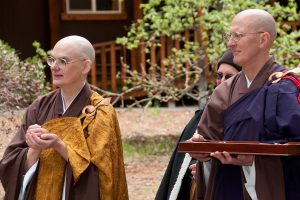 Shasta Abbey, located on sixteen forested acres near Mount Shasta in Northern California (USA), is a training monastery for Buddhist monks and a place of practice for lay Buddhists and interested visitors. A monastery of the Order of Buddhist Contemplatives (OBC), it was established in 1970 by Rev. Master Jiyu-Kennett, a British woman, on behalf of her teacher, Keido Chisan Koho Zenji, her Master in Japan. In November 1969, Rev. Master Jiyu-Kennett came to San Francisco on a lecture tour and stayed on in the United States to establish Shasta Abbey the following year. Rev. Master Jiyu-Kennett served twenty-six years as Abbess and spiritual director of Shasta Abbey, ordaining and teaching monks and lay people. She founded Throssel Hole Buddhist Abbey in England in 1972. She also founded the OBC to establish a framework within which the temples she founded could come together. She was head of the OBC until her death on November 6, 1996. Her legacy includes a growing Order with vibrant training monasteries, priories, meditation groups and individual practitioners throughout the world, rich teaching for monks and laity in the form of publications and audio talks, liturgy and ceremonial.
Shasta Abbey, located on sixteen forested acres near Mount Shasta in Northern California (USA), is a training monastery for Buddhist monks and a place of practice for lay Buddhists and interested visitors. A monastery of the Order of Buddhist Contemplatives (OBC), it was established in 1970 by Rev. Master Jiyu-Kennett, a British woman, on behalf of her teacher, Keido Chisan Koho Zenji, her Master in Japan. In November 1969, Rev. Master Jiyu-Kennett came to San Francisco on a lecture tour and stayed on in the United States to establish Shasta Abbey the following year. Rev. Master Jiyu-Kennett served twenty-six years as Abbess and spiritual director of Shasta Abbey, ordaining and teaching monks and lay people. She founded Throssel Hole Buddhist Abbey in England in 1972. She also founded the OBC to establish a framework within which the temples she founded could come together. She was head of the OBC until her death on November 6, 1996. Her legacy includes a growing Order with vibrant training monasteries, priories, meditation groups and individual practitioners throughout the world, rich teaching for monks and laity in the form of publications and audio talks, liturgy and ceremonial.
The second Abbot was Rev. Master Eko Little, a Dharma Heir of Rev. Master Jiyu-Kennett and her assistant for 20 years. He succeeded Rev. Master Jiyu after her death and served as Abbot until 2010. He maintained his Master’s wishes for, and legacy to, Shasta Abbey in the 14 years following her death. In his time as Abbot, he continued to unfold Rev. Master Jiyu’s teaching, strengthening the fabric of the monastery, and enhancing the spiritual life of the Sangha, both monastic and lay. There were also some serious problems that came to light towards the end of his Abbacy, and in May, 2010, he left the Abbey and returned to lay life.
The third, and current, Abbess is Rev. Master Meian Elbert, who was ordained in 1977 and received Dharma Transmission in 1979 from Rev. Master Jiyu-Kennett. She was named a Master of the Order by Rev. Master Jiyu in 1989. She was chaplain to Rev. Master Jiyu for more than 15 years and has served the community as Vice Abbess, Chief Cook, Chief Precentor, Prior and Novice Master. Both the lay and monastic communities have benefited from her Dharma Talks, the extended retreats she has led and her writings. She also served as Executive Secretary of the Order of Buddhist Contemplatives. Rev. Master Meian was elected Abbess by the resident Shasta Abbey monastic community on June 17, 2010.
The resident monastic community includes approximately 20 female and male monks. Our monastic community is vegetarian and celibate. The Abbey is a place of silence and serenity for our local congregation, lay friends and interested visitors. We welcome all who are interested in our practice to visit and spend time with us, either in the formal setting of retreats and ceremonies or the ongoing engagement with our practice that comes as a lay resident. Lay residents and retreat guests follow the monastic schedule which provides a balance of sitting meditation, working meditation and ceremonial in order to cultivate the mind of meditation in all aspects of daily life. The schedule need not be a barrier for those with physical disabilities. A hearing assistance system is available for Dharma Talks in the Buddha Hall; ramps are available throughout the monastery for wheelchair accessibility. Other physical concerns can be discussed with the Guestmaster.
Traditionally, in order to help the monks continue to deepen their training and offer the Dharma, the laity offer alms and receive instruction on how to put the Dharma into practice to benefit themselves and the world. Mutual respect and kindness develop among members of the Sangha, and thus the practice of dana – mutual assistance – assists each of us in making our training a success. There really can be no price put on the Buddha Dharma. Thus, we at Shasta Abbey have chosen not to have fees or even suggested donation amounts. We make an offering of the teaching, and provide a training refuge, putting our faith in the practice of dana. Shasta Abbey truly lives and functions through lay financial support which provides the traditional “four requisites” of food, lodging, robes and medicine for monks. Shasta Abbey is registered as a 501(c)3 corporation in California (USA). Donations are tax deductible.
For contact information, location and directions, please see the Contact page.
